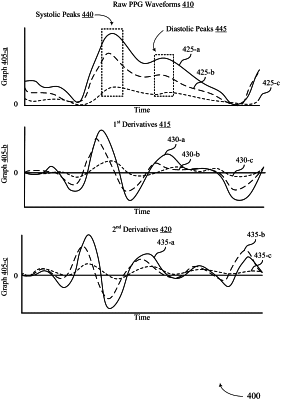| CPC A61B 5/021 (2013.01) [A61B 5/6802 (2013.01); A61B 5/742 (2013.01); A61B 5/7475 (2013.01); A61B 5/02438 (2013.01); A61B 2560/0223 (2013.01)] | 17 Claims |

|
1. A wearable device for measuring blood pressure, comprising:
one or more light-emitting components configured to emit light associated with at least a first wavelength and a second wavelength;
one or more photodetectors configured to receive light emitted by the one or more light-emitting components; and
a controller communicatively coupled to the one or more light-emitting components and the one or more photodetectors, the controller configured to:
transmit, during a time interval including a heartbeat of a user and using the one or more light-emitting components, first light associated with the first wavelength and second light associated with the second wavelength;
acquire photoplethysmogram (PPG) data from the user based at least in part on receiving the first light and the second light via the one or more photodetectors, the PPG data comprising at least a first PPG waveform acquired using the first light associated with the first wavelength and a second PPG waveform acquired using the second light associated with the second wavelength;
determine a second derivative of the first PPG waveform associated with the first wavelength, and an additional second derivative of the second PPG waveform associated with the second wavelength;
determine a peak of the second derivative corresponding to a systolic peak of the first PPG waveform, and a peak of the additional second derivative corresponding to a systolic peak of the second PPG waveform;
determine a first set of morphological features associated with the first PPG waveform based at least in part on the systolic peak and a diastolic peak corresponding to the heartbeat within the first PPG waveform, wherein the first set of morphological features comprise the peak of the second derivative of the first PPG waveform;
determine a second set of morphological features associated with the second PPG waveform based at least in part on the systolic peak and a diastolic peak corresponding to the heartbeat within the second PPG waveform, wherein the second set of morphological features comprise the peak of the additional second derivative of the second PPG waveform; and
determine a blood pressure metric for the user based at least in part on a comparison of the first set of morphological features and the second set of morphological features and based at least in part on a delay between the peak of the second derivative of the first PPG waveform and the peak of the additional second derivative of the second PPG waveform.
|